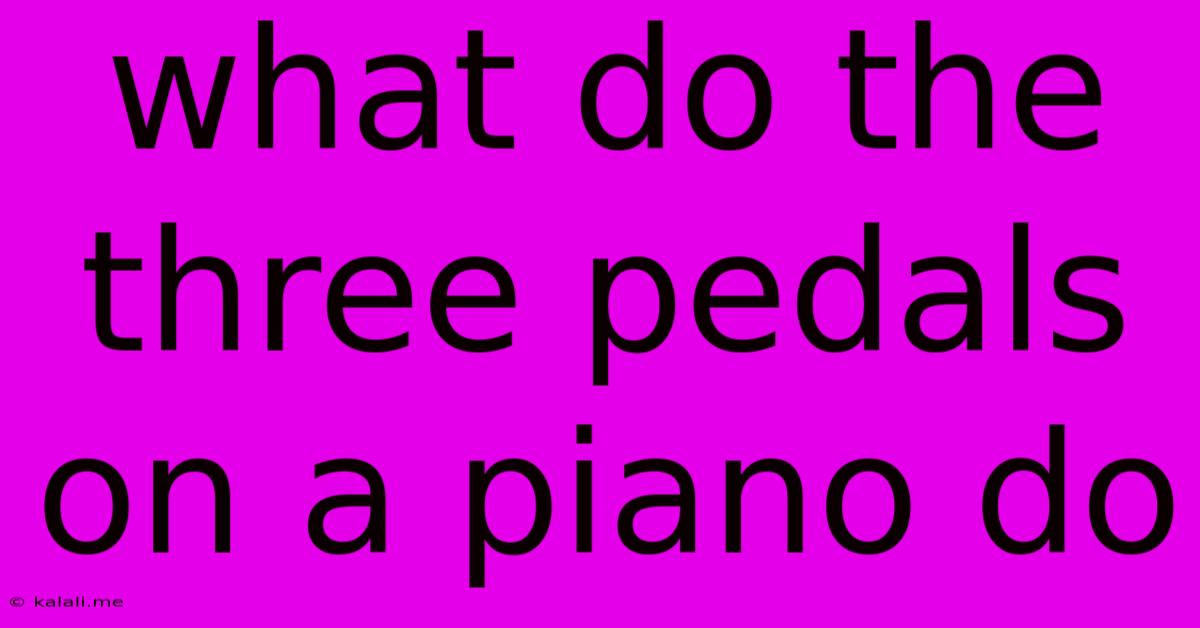What Do The Three Pedals On A Piano Do
Kalali
Jun 01, 2025 · 3 min read

Table of Contents
What Do the Three Pedals on a Piano Do? A Comprehensive Guide
So, you're looking to understand the mysteries of the piano pedals? Many beginners are intimidated by these three enigmatic levers, but mastering them is key to unlocking the full expressive potential of the instrument. This guide will break down the function of each piano pedal, providing you with a clear understanding of their individual roles and how they can be used in combination to create a richer, more nuanced musical experience. This will cover the sustain pedal, the soft pedal (una corda), and the sostenuto pedal.
The Sustain Pedal: The Workhorse of Piano Pedaling
The rightmost pedal, often called the damper pedal or sustain pedal, is the most commonly used pedal on the piano. Its primary function is to lift the dampers from the strings, allowing the sound to resonate freely after the key is released. This creates a rich, lingering sound, blurring the lines between notes and providing a sense of continuity.
-
Sustaining Notes: The most obvious function is to sustain notes. Holding the sustain pedal down while playing a chord will cause the chord to ring out even after you release the keys.
-
Connecting Chords: Using the sustain pedal strategically between chords can create a smoother transition, avoiding abrupt breaks in the musical line. This is particularly important in legato passages.
-
Creating a Wash of Sound: The sustain pedal is crucial in building texture and atmosphere. By carefully managing its application, you can create a beautiful wash of sound, ideal for expressive passages or dramatic climaxes.
-
Harmonics and Resonance: The sustain pedal can also bring out sympathetic vibrations (harmonics) from other strings, adding to the overall richness and complexity of the sound.
Mastering the sustain pedal requires practice and a keen ear. Overusing it can lead to a muddy, indistinct sound, while underusing it can result in a choppy, disconnected performance.
The Soft Pedal (Una Corda): Adding Subtlety and Nuance
Located in the middle, the soft pedal (also known as the una corda pedal, meaning "one string" in Italian) shifts the hammers slightly to the side, causing them to strike fewer strings than usual. This results in a quieter, more delicate sound with a slightly different timbre.
-
Quieter Dynamics: Its primary function is to reduce the volume of the piano.
-
Timbral Variations: Beyond simply decreasing volume, the soft pedal changes the tone color (timbre) of the piano slightly, often adding a subtle sweetness or ethereal quality.
-
Adding Delicacy to Passages: This pedal is incredibly useful for creating delicate and intimate passages within a piece.
Unlike the sustain pedal, which is often used continuously, the soft pedal is often used more sparingly and precisely.
The Sostenuto Pedal: Selective Sustain
The leftmost pedal, the sostenuto pedal, is the least commonly used and often the least understood. Unlike the sustain pedal, which affects all the strings, the sostenuto pedal only sustains the notes that were already being played when the pedal was depressed. Releasing the keys doesn't stop the notes that are being sustained by the sostenuto pedal.
-
Sustaining Specific Notes: This allows for selective sustaining of certain notes within a chord or melody, leaving other notes unaffected.
-
Creating Complex Textures: This is ideal for creating more complex textures and harmonic interplay, particularly useful in more advanced piano pieces.
-
Layered Sounds: It allows for layering of sounds, providing a broader palette of sonic possibilities.
While less frequently used, the sostenuto pedal offers unique capabilities for shaping the sound and texture of a piano performance.
Combining Pedals for Expressive Power
The true power of piano pedals lies in their combination. By carefully manipulating all three pedals simultaneously, pianists can create incredibly nuanced and expressive performances, crafting a unique sonic landscape with each piece.
Mastering the art of pedaling takes time, dedication, and a sensitive ear, but the rewards are immense. By understanding the specific functions of each pedal and experimenting with their combinations, you will unlock a whole new level of musical expression and control.
Latest Posts
Latest Posts
-
If You Or Someone You Know
Jun 03, 2025
-
Skyrim Se Faster Keyboard Input Mod
Jun 03, 2025
-
How Can I Remove Dried Grout From Tiles
Jun 03, 2025
-
What Does Doc Ock Want In Tritium
Jun 03, 2025
-
Variance Of The Product Of Two Random Variables
Jun 03, 2025
Related Post
Thank you for visiting our website which covers about What Do The Three Pedals On A Piano Do . We hope the information provided has been useful to you. Feel free to contact us if you have any questions or need further assistance. See you next time and don't miss to bookmark.